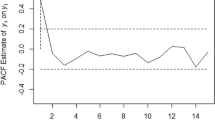Abstract
Serial dependence often prevents researchers from obtaining unbiased parameter estimates. In this article, we propose taking serial dependence into account, and exploiting the information that comes with serial dependence. This can be done in the form of shifted variables that are included in addition to the original variables, when models are specified. This way, models become more complex but relations can be considered that, otherwise, cannot be analyzed. Two fields of application are discussed. The first is log-linear modeling. This method is variable-oriented, but it has found applications in person-oriented research. The gain from including shifted variables in log-linear models is that new, specific variable relations can be analyzed. The second field is that of Configural Frequency Analysis. This method is person-oriented, and it allows researchers to detect local relations that, without consideration of shifted variables, cannot be detected. Application examples are given in the context of single-case analysis.
Similar content being viewed by others
Notes
Please note that, with reference to the hierarchy of global CFA base models (see von Eye, & Wiedermann, 2022), the P-CFA base model discussed here could be considered a first order base model. A second order P-CFA base model could be specified by taking all first order interactions among predictors and criterion variables into account. Accordingly, higher order P-CFA base models can be considered. In the present article, we focus on first order P-CFA base models.
References
Agresti, A. (2012). Categorical data analysis (3rd ed.). Wiley. ISBN-10: 9780470463635.
Bartoszyk, G. D., & Lienert, G. A. (1978). Konfigurationsanalytische Typisierung von Verlaufskurven. Zeitschrift Für Experimentelle Und Angewandte Psychologie, 25, 1–9.
Glen, S. (2021). Serial correlation/autocorrelation: Definition, tests. StatisticsHowTo.com: Elementary Statistics for the rest of us! Downloaded on May 22, 2023 from: https://www.statisticshowto.com/serial-correlation-autocorrelation/
Heilmann, W. R., Lienert, G. A., & Maly, V. (1979). Prediction models, in Configural Frequency Analysis. Biometrical Journal, 21, 79–86. https://doi.org/10.1002/bimj.4710210110
Holland, B. S., & Di Ponzio Copenhaver, M. (1987). An improved sequentially rejective Bonferroni test procedure. Biometrics, 43, 417–423.
Krauth, J. (1973). Nichtparametrische Ansätze zur Auswertung von Verlaufskurven. Biometrische Zeitschrift, 15, 557–566. https://doi.org/10.1002/bimj.19730150804
Krauth, J., & Lienert, G. A. (1978). Nonparametric two-sample comparison of learning curves based on orthogonal polynomials. Psychological Research, 40, 159–171. https://doi.org/10.1007/BF00308411
Lehmacher, W. (2000). Die Konfigurationsfrequenzanalyse als Komplement des log-linearen Modells. Psychologische Beiträge, 42, 418–427.
Lienert, G. A., & Krauth, J. (1975). Configural frequency analysis as a statistical tool for defining types. Educational and Psychological Measurement, 35(2), 231–238. https://doi.org/10.1177/001316447503500201
Perrine, M. W., Mundt, J. C., Searles, J. S., & Lester, L. S. (1995). Validation of daily self-reported alcohol consumption using interactive voice response (IVR) technology. Journal of Studies on Alcohol, 56(5), 487–490. https://doi.org/10.15288/jsa.1995.56.487
von Eye, A. (2004). Base models for configural frequency analysis. Psychology Science, 46, 150–170.
von Eye, A., & Gutiérrez Peña, E. (2004). Configural Frequency Analysis - the search for extreme cells. Journal of Applied Statistics, 31, 981–997.
von Eye, A., Indurkhya, A., & Kreppner, K. (2000). CFA as a tool for person-oriented research - Unidimensional and within-individual analyses of nominal level and ordinal data. Psychologische Beiträge, 42, 383–401.
von Eye, A., & Mair, P. (2008). A functional approach to Configural Frequency Analysis. Austrian Journal of Statistics, 37, 161–173.
von Eye, A., & Mun, E.-Y. (2013). Log-linear modeling - Concepts, Interpretation and Applications. Wiley. ISBN-10: 1118146409.
von Eye, A., & Nesselroade, J. R. (1992). Types of change: Application of Configural Frequency Analysis to repeated observations in developmental research. Experimental Aging Research, 18, 169–183.
von Eye, A., & Schuster, C. (1998). On the specification of models for Configural Frequency Analysis - Sampling schemes in Prediction CFA. Methods of Psychological Research - Online, 3, 55–73.
von Eye, A., & Wiedermann, W. (2016). Direction of effects in categorical variables - A structural perspective. In W. Wiedermann & A. von Eye (Eds.), Statistics and causality: Methods for Applied Empirical Research (pp. 107–130). Wiley.
von Eye, A., & Wiedermann, W. (2023). Latent variable analysis in person-oriented research – serial dependence. Merrill Palmer Quarterly (under review)
von Eye, A., Wiedermann, W., & von Weber, S. (2021). Configural analysis of oscillating progression. Journal of Person-Oriented Research, 7, 14–21.
von Eye, A., & Wiedermann, W. (2022). Configural frequency analysis. foundations, models, and applications. New York: Springer.
von Eye, A., Mair, P., & Mun, E.-Y. (2010). Advances in configural frequency analysis. New York: Guilford Press.
von Eye, A., Wiedermann, W., & von Weber, S. (2023). Latent variables analysis in person-oriented research. Journal of Person-oriented Research. (in press)
Author information
Authors and Affiliations
Contributions
AvE drafted the main manuscript. AvE, WW, and EYM analyzed and interpreted the data; WW and EYM reviewed and edited the manuscript. All authors have read and approved the final manuscript.
Ethics declarations
Competing interests
The authors declare no competing interests.
Additional information
Publisher's Note
Springer Nature remains neutral with regard to jurisdictional claims in published maps and institutional affiliations.
Rights and permissions
Springer Nature or its licensor (e.g. a society or other partner) holds exclusive rights to this article under a publishing agreement with the author(s) or other rightsholder(s); author self-archiving of the accepted manuscript version of this article is solely governed by the terms of such publishing agreement and applicable law.
About this article
Cite this article
von Eye, A., Wiedermann, W. & Mun, EY. Log-Linear and Configural Analysis of Intra-Individual Time Series under Consideration of Serial Dependence. Integr. psych. behav. 58, 759–770 (2024). https://doi.org/10.1007/s12124-023-09815-7
Accepted:
Published:
Issue Date:
DOI: https://doi.org/10.1007/s12124-023-09815-7




